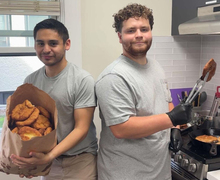University readies for swine flu
Shawn Ward has been coughing for two days. He doesn’t believe he has swine flu, but he knows that it’s likely in someone like himself – a college student.
‘I read in the news that in Washington (State University), there were a bunch of outbreaks,’ said Ward, a sophomore music education major. ‘With a campus as big as ours, I’m surprised that we haven’t had the same thing. One student can get it, and then it becomes a pandemic.’
Syracuse University has diagnosed only three people with H1N1 symptoms as of Monday. James Jacobs, director of Health Services, said the number of preparations SU has made for the virus, so far, played a role in the small number of cases on campus.
‘We’ve sent e-mails; we’ve told teachers to put information about the virus on their syllabi,’ Jacobs said. ‘We’re trying to make sure that everyone on campus knows about the severity of the virus.’
Unlike the regular influenza virus, young adults are more susceptible to H1N1 than small children and senior citizens, said Ernest Hemphill, a microbiology professor at SU. This makes a college setting favorable for the spread of the virus, he said.
Washington State University recently reported 2,000 students with influenza-like symptoms, one of the largest outbreaks this year at a university. Cornell University has also seen signs of the virus in more than 200 students, including one who had to be hospitalized.
People have become increasingly nervous about this strain of the virus, as opposed to others, because the virus’ trajectory is similar to the worldwide H1N1 outbreak in 1917. That virus led to an estimated 50 million deaths in 1917 and 1918.
SU Health Services will begin administering free seasonal flu shots this Friday, Jacobs said.
Though an H1N1 vaccine will eventually be made available to the university by the federal government, the amount of vaccines, and when SU would receive them, is currently unknown, Jacobs said.
SU has started putting together ‘flu packs’ for the few students that have shown H1N1 virus symptoms. Other universities are making similar packages available, which include pain relievers and masks to cover the mouth and nose.
‘If a student is diagnosed with an influenza-like illness, (flu packs) will be given that will provide comfort for the sick student and will prevent the illness from being passed from the sick student to healthy ones,’ Jacobs said.
Hemphill and Jacobs both said another reason SU has not been hit as hard as surrounding areas, is due to sheer coincidence.
‘It’s just good luck,’ Jacobs said. ‘For some reason or another, the virus has been delayed. If we get away without having a considerable amount of cases, it’s lucky.’
University officials spoke with faculty prior to the start of the semester about the importance of students missing class if they exhibit H1N1 symptoms. They advised students should remain in dorm rooms or apartments until the flu-like symptoms stop.
‘I would hope teachers would be accommodating if students are out sick,’ said Michelle Matuszak, a sophomore history major. ‘I would not go to class, but I’m sure there are some students that would.’
Hemphill said teachers should remain flexible (for students) in case of an actual sickness.
‘Kids try to carry themselves to class, thinking that they can’t miss a lesson or an exam. But at the same time, the faculty is going to have to make some preparations to keep students at home,’ Hemphill said. ‘As a faculty member, I know that some people are going to take advantage of that, but we want to make sure that the virus isn’t being spread in our classes.’
Jacobs and Hemphill agreed that isolation and hand washing are the easiest ways to prevent the spread of the H1N1 virus.
Hemphill said the colder weather in winter promotes the spread of influenza and will make the H1N1 virus harder to get rid of. The Southern Hemisphere has experienced an influx of people exhibiting H1N1 symptoms as it approaches the end of their winter season.
Both North and South America totaled more than 2,200 deaths due to the virus since Aug. 30, according to the World Health Organization. There have been an estimated 2,837 deaths worldwide.
Published on September 8, 2009 at 12:00 pm





